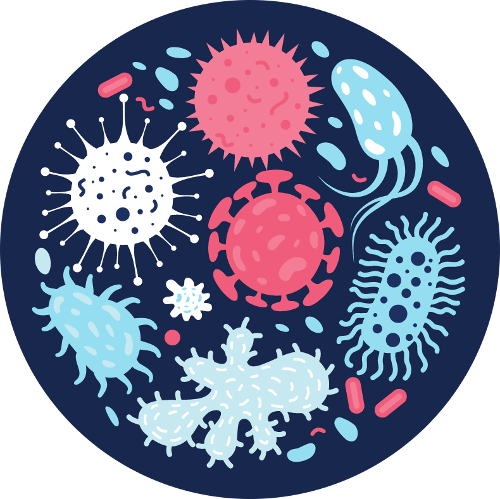An epidemic of childhood aflatoxin exposure Far-reaching impacts on children’s development
of newborns in Kenya have been exposed to aflatoxin (but less than 1% in the US and Europe).
of breastmilk in Tanzania contains unsafe levels of aflatoxin.
of children under 3 have aflatoxin in their blood.
Our beloved children, with their bodies and minds still growing, are the most vulnerable members of our families and communities. The health damage done by aflatoxin – particularly to the immune and digestive systems – hits them the hardest, causing stunted growth and poor development.
While the danger of aflatoxin to our children is frightening, we have the opportunity to prevent it, and to give the gift of better health to whole generations.
Health experts talk about a child’s “first 1,000 days”, from the moment of conception to their second birthday. This is a crucial period, when children need the right nutrition to grow, develop and learn at breakneck speed, and when the foundations are laid for their future health – for good or ill.
This makes it a top priority to keep aflatoxin out of babies’ and children’s milk and food, as well as protecting pregnant and nursing mothers. While the danger to our children is frightening, we have the opportunity to prevent it, and to give the gift of better health to whole generations of Africans for the rest of their lives, by using Aflasafe to treat our crops – as well as encouraging other good practices, regulation, and public awareness – to make food safe for infants and their mothers.
At present, almost every child in Africa is exposed to aflatoxin. Each stage of the first 1,000 days and beyond offers both serious risks and opportunities for our children’s health:
- Before birth, aflatoxin can cross the placenta and reach the foetus. It is linked to low birthweight in babies.
- From birth, babies can begin to consume aflatoxin in milk if their mothers have been exposed. Over 90% of breastmilk samples from Tanzanian mothers had aflatoxin levels over the safe limit for infant foods.
- As growing children, weaning onto solid food means more potential sources of aflatoxin exposure. Contamination is common in many of the foods we give to infants, such as maize and groundnuts, as well as in cow’s milk and in commercial baby food produced in Africa.
An epidemic of childhood aflatoxin exposure
 Our cultures, languages and diets may vary, but aflatoxin exposure is an almost universal part of an African childhood. Whether a child grows up running in countryside fields, or learning to navigate city streets – and whether they’re born to the richest family with everything they could want, or to the poorest family giving them everything they can – aflatoxin is their silent playfellow. Those growing up in poverty do however suffer the most, since their diets are less diverse and more likely to be contaminated.
Our cultures, languages and diets may vary, but aflatoxin exposure is an almost universal part of an African childhood. Whether a child grows up running in countryside fields, or learning to navigate city streets – and whether they’re born to the richest family with everything they could want, or to the poorest family giving them everything they can – aflatoxin is their silent playfellow. Those growing up in poverty do however suffer the most, since their diets are less diverse and more likely to be contaminated.
Aflatoxin in the womb
Aflatoxin has been found in blood and urine samples from pregnant women across Africa, including in The Gambia, Ghana, Kenya, Nigeria, Sierra Leone, and Uganda. By crossing the placenta from the mother’s bloodstream to her child’s, aflatoxin gets to babies even before they are born. We know that foetuses exposed to aflatoxin in the womb undergo DNA-methylation changes – potentially affecting the way the DNA in their cells works for the rest of their lives.
In Kenya, a 2013 analysis of blood samples from umbilical cords found that more than three-quarters (77%) of newborns had been exposed to aflatoxin. In comparison, in Europe and the USA that figure is less than 1%. Prenatal exposure to the toxin has been associated with low birthweight.
Infancy and beyond
Although breastmilk is otherwise the perfect nourishment for babies, it is often a source of aflatoxin exposure from the first day of a child’s life. The toxin passes through a mother’s body and enters her milk in a similar form. For example, in technical terms, the most dangerous form of aflatoxin, known as aflatoxin B1, is converted into a toxic metabolite, aflatoxin M1, which is what gets into breastmilk.
In Tanzania, scientists analysed samples from mothers with babies under six months old. Over 90% of those breastmilk samples not only contained aflatoxin but had so much of the toxin that it was over the level considered safe for infant foods by the European Union.
In order to keep our children on a healthy lifelong path, it is essential to cut aflatoxin out of their and their mothers’ food.
 However, it is when weaning starts that an infant’s intake of aflatoxin really explodes, since they are consuming the toxin directly rather than having some buffer from their mother – and many nutritious foods used for weaning are also prone to aflatoxin contamination, such as maize and groundnuts. This makes early weaning, starting before the age of six months as is common in many countries, a bad idea.
However, it is when weaning starts that an infant’s intake of aflatoxin really explodes, since they are consuming the toxin directly rather than having some buffer from their mother – and many nutritious foods used for weaning are also prone to aflatoxin contamination, such as maize and groundnuts. This makes early weaning, starting before the age of six months as is common in many countries, a bad idea.
Another important source of nourishment for many children is milk, helping them build bones and teeth and supplying plenty of energy. Unfortunately, it is often contaminated with aflatoxin too. Just like humans, when dairy animals eat grain that contains the toxin it passes through into their milk in metabolised forms such as aflatoxin M1.
A study in Nairobi tested milk from households and retailers, and found that out of hundreds of milk samples every single one contained aflatoxin, and 63% had levels of toxin over the safe limits recommended by the European Union. Local children were also measured, and 41% were suffering from stunting and poor growth. This is not an isolated issue: the situation is similar in Ethiopia, and likely in many other places.
All of this means that children’s exposure to aflatoxin gradually increases and accumulates over their first 1,000 days, becoming almost universal. A study in Tanzania, which started with children aged 12–22 months, looked at markers of aflatoxin exposure in blood samples. Six months in, 84% showed signs of aflatoxin, while after 12 months 99% of the children had been exposed to aflatoxin. Children who had been fully weaned had more aflatoxin in their blood, as did children who had eaten more maize in their food.
 Meanwhile in Benin and Togo, scientists analysed blood samples from children aged from zero to five years old, and found that 99% had been exposed to aflatoxin. The amount of aflatoxin in the blood increased with age, reaching alarmingly high levels in some children – and, as we’ll discuss below, the children with most exposure were the most stunted. Similar research in Uganda, this time of children aged zero to three years old, found that 96% had been exposed to aflatoxin.
Meanwhile in Benin and Togo, scientists analysed blood samples from children aged from zero to five years old, and found that 99% had been exposed to aflatoxin. The amount of aflatoxin in the blood increased with age, reaching alarmingly high levels in some children – and, as we’ll discuss below, the children with most exposure were the most stunted. Similar research in Uganda, this time of children aged zero to three years old, found that 96% had been exposed to aflatoxin.
By the time our children are ready for their first day at school, almost all are already carrying the burden of aflatoxin within their bodies. This exposure will only grow as they continue their journeys through life, eating contaminated foods without knowing. Some have so far accumulated only harmless amounts of aflatoxin, whereas others have already paid high prices, such as stunted growth, malnutrition, vulnerability to diseases, underdevelopment, and poor learning. To keep our children on a healthy lifelong path, it is essential to cut aflatoxin out of their and their mothers’ food.
Far-reaching impacts on children’s development
Aflatoxin damages children’s health, particularly their immune and digestive systems. It has detrimental effects on their physical growth, including stunting, wasting, and low weight. At the same time, it hinders their learning and development. It makes them weaker against childhood illnesses, and is linked to malnutrition and nutrient deficiencies.
We have a huge opportunity to give children better health for the rest of their lives, by keeping aflatoxin out of their food and milk.
With childhood exposure almost universal in Africa, it is probable that aflatoxin is having a widespread and far-reaching effect on children’s health. Aflatoxin works slowly and invisibly, and may be part of a child’s poor health and development without ever being recognised as such.

With their bodies still forming fast, aflatoxin damage can have a lifelong impact on children’s wellbeing, potential, health and happiness. Children are also particularly vulnerable, as their bodies’ abilities to detoxify and fight aflatoxin are still undeveloped. This means that we have a huge opportunity to give children better health for the rest of their lives, by keeping aflatoxin out of their food and milk.
Stunted development
Children with more aflatoxin in their blood are more stunted and underweight, as shown by a seminal study conducted by IITA in West Africa. Stunting is worryingly common across the continent, affecting 30–50% of children in most countries. In total, 58.7 million children under five are stunted (too short for their age), and 13.8 million are wasted (too thin for their height). Clearly, any factor that contributes to this problem is potentially very important.
Scientists still haven’t fully untangled the connections between bad nutrition, immune damage, and stunting and poor development, but we know that aflatoxin feeds in to that vicious cycle, making children sicklier, smaller and less able to thrive. A clear relationship between aflatoxin and stunting has been found in a number of countries, including Benin, The Gambia, Kenya, Tanzania and Togo.
Stunted children suffer long-term developmental and cognitive problems.
For example, in Benin and Togo, stunted and/or underweight children had 30-40% more aflatoxin in their blood than children of normal weight. In this study, aflatoxin produced what is called a “dose-dependent response”, meaning that the more the children were exposed to aflatoxin the shorter, more stunted they were.
Taking another approach, in Kenya, scientists measured the amount of aflatoxin in household supplies of maize flour, and found that it correlated with wasting in the family’s children. Higher aflatoxin levels have also been linked to slower growth. There are likely to be several factors at work, with both immune and digestive damage playing their part.
A child’s physical size is not necessarily important in itself, but stunted children very often suffer from long-term developmental and cognitive problems too, creating learning difficulties and stifling their full potential.
These effects on development make themselves felt even in the womb. Higher levels of aflatoxin in mothers and babies are correlated with lower birthweight and size, greater risk of stillbirth, and poor growth of newborns.
Doors to illness
 Aflatoxin opens many doors to illness – doors that we can close by keeping aflatoxin out. By damaging and suppressing the immune system, aflatoxin makes our children weaker against whatever childhood illnesses and infections come along. It also seems to make vaccines less effective, compounding that vulnerability.
Aflatoxin opens many doors to illness – doors that we can close by keeping aflatoxin out. By damaging and suppressing the immune system, aflatoxin makes our children weaker against whatever childhood illnesses and infections come along. It also seems to make vaccines less effective, compounding that vulnerability.
Aflatoxin also causes gastrointestinal inflammation and damage, which stops the body from absorbing nutrients properly from food, potentially causing malnutrition and nutrient deficiencies – especially catastrophic in growing children in need of plenty of nourishment. Malnutrition also makes children less able to fight against the effects of aflatoxin, creating a vicious cycle of damage and further weakness.
More research is needed in this area, but there is evidence linking high levels of aflatoxin in the blood with vitamin A, vitamin C, zinc, and other micronutrient deficiencies, in both adults and children. A study in Guinea analysed blood samples from children aged two to three years old, and divided them up into four groups, or quartiles, by their level of aflatoxin exposure. Children with the highest exposure to the toxin were twice as likely to suffer from zinc deficiency and 3.5 times as likely to be vitamin A deficient compared to children in the lowest-exposure group.
Aflatoxin appears to contribute to kwashiorkor, a type of protein-energy malnutrition that occurs when the body does not take in enough protein. Scientists in Nigeria looked at blood samples from children under five, and found aflatoxin exposure in 93% of those little ones suffering from marasmic kwashiorkor and in 89% of those with kwashiorkor, compared to 64% of healthy children. Similar evidence, showing that aflatoxin is found more often and at higher levels in children with kwashiorkor, has been found in other countries including Cameroon, Sudan and Zambia.
It is difficult to trace causation over decades, especially decades of ongoing toxin accumulation, but childhood exposure to aflatoxin also seems to lead to a greater risk of cardiovascular diseases and cancer later in life – underscoring the far-reaching benefits of cutting out aflatoxin from day one of a child’s existence.
Return to the food safety and health page to find out about other ways aflatoxin harms us, and how we can improve food safety.










